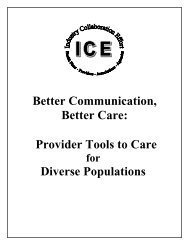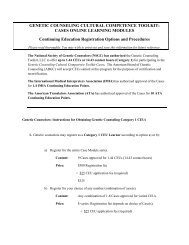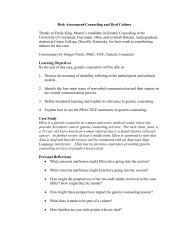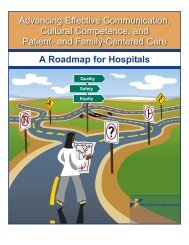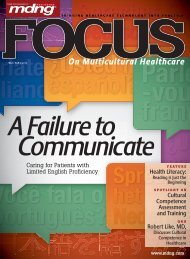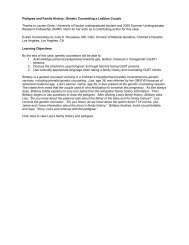making the business case for culturally and linguistically appropriate ...
making the business case for culturally and linguistically appropriate ...
making the business case for culturally and linguistically appropriate ...
Create successful ePaper yourself
Turn your PDF publications into a flip-book with our unique Google optimized e-Paper software.
equiring interpretation, clinical assessment or intervention. The two-tiered model providesdirect, live access at <strong>the</strong> point of entry into <strong>the</strong> health plan.Based on data collected during December 2004 through February 2005, Molina’s TeleSaludprogram produced a cost-savings of $2,448 per month during <strong>the</strong> pilot phase, totaling anextrapolated annual cost-savings of $29,000. Expansion of <strong>the</strong> program to cover all ofMolina’s members in all states yielded a savings ranging from $0.14 to $1.35 per memberper year in calendar year 2005-2006, totaling over $750,000 cost-savings. The state with <strong>the</strong>greatest savings was Cali<strong>for</strong>nia, <strong>the</strong> state with <strong>the</strong> greatest percentage of Spanish-speakingmembers. In addition to <strong>the</strong> fiscal savings, <strong>the</strong> project’s o<strong>the</strong>r gains, although lessquantifiable, are just as valuable. The TeleSalud project has provided o<strong>the</strong>r departments in<strong>the</strong> Molina system numerous value-added services, to include a substantial increase inbilingual capacity <strong>for</strong> nurse advice services; as a result of TeleSalud <strong>the</strong> staff is now 100%bilingual in Spanish.UCare Minnesota (Minneapolis, MN)UCare Minnesota is an independent, nonprofit, local health plan that provides nearly 140,000Minnesotans with <strong>the</strong> health coverage plans <strong>and</strong> services <strong>the</strong>y need to maintain <strong>and</strong> improve<strong>the</strong>ir health. As Minnesota’s population increasingly becomes increasingly diverse, so do <strong>the</strong>in<strong>for</strong>mation needs of <strong>the</strong>ir health care consumers. Production <strong>and</strong> distribution of materials in<strong>the</strong> most common of <strong>the</strong> 124 languages now spoken in Minnesota represents a significantexpense, as well as a technical challenge <strong>for</strong> any one health plan or facility. As a resultUCare collaboratively established <strong>the</strong> Multilingual Health Resource Exchange (Exchange), aweb-based clearinghouse <strong>for</strong> health consumer materials specifically developed <strong>for</strong> LimitedEnglish Proficient (LEP) patients. In order to improve access to health in<strong>for</strong>mation <strong>for</strong> LEPmembers, UCare collaborated with over a dozen o<strong>the</strong>r Minnesota health care organizations(including o<strong>the</strong>r health plans such as HealthPartners, Blue Cross Blue Shield of Minnesota,<strong>and</strong> Medica) that contribute annual funding to support a web-based clearinghouse of healthresources in multiple languages <strong>and</strong> make <strong>the</strong> clearinghouse resources easily accessible tohealth care providers serving LEP patients.Exchange partner organizations pay $2,500/organization each year to support <strong>the</strong> web-basedclearinghouse with over 1,600 materials in it. A conservative estimate is that it costs $300 toproduce language-specific versions of each material, equally a value of $480,000 roughly to<strong>the</strong> current Exchange collection of materials. Some of <strong>the</strong>se materials are public domain <strong>and</strong>available at no cost but many providers do not have <strong>the</strong> time to explore <strong>the</strong> internet to find<strong>the</strong> health topics <strong>the</strong>y need in <strong>the</strong> languages required by <strong>the</strong>ir LEP patients.• Organizational Supports <strong>for</strong> Cultural CompetenceEliminating health disparities through successful CLAS interventions can be complex <strong>and</strong>require a self-assessment <strong>for</strong> CLAS readiness, a strategic plan that includes data collection<strong>and</strong> long-term partnerships utilizing existing community resources. Faced with increasinglanguage services dem<strong>and</strong>s, <strong>and</strong> in <strong>the</strong> absence of adequate numbers of on-site qualifiedhealth care interpreters, health care organizations are beginning to turn to <strong>the</strong>ir own diversework <strong>for</strong>ce <strong>for</strong> a partial solution. Kaiser Permanente has responded to this situation with anumber of initiatives that promote <strong>culturally</strong> competent care, improve health outcomes, <strong>and</strong>eliminate health care disparities, including <strong>the</strong> design <strong>and</strong> implementation of <strong>the</strong> Health CareInterpreter Certificate Program, <strong>and</strong> <strong>the</strong> Qualified Bilingual Staff (QBS) Model. The Young16



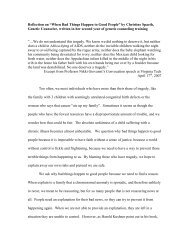
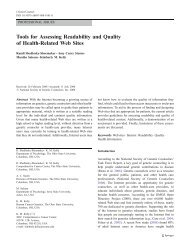

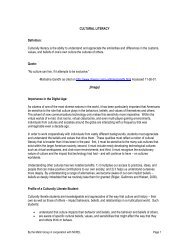
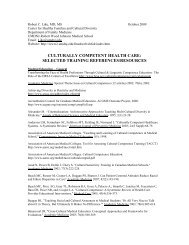

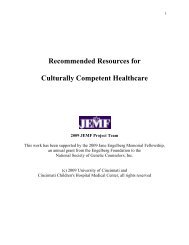
![Breaking Bad News PPT[1] - Genetic Counseling Cultural ...](https://img.yumpu.com/35003134/1/190x146/breaking-bad-news-ppt1-genetic-counseling-cultural-.jpg?quality=85)
